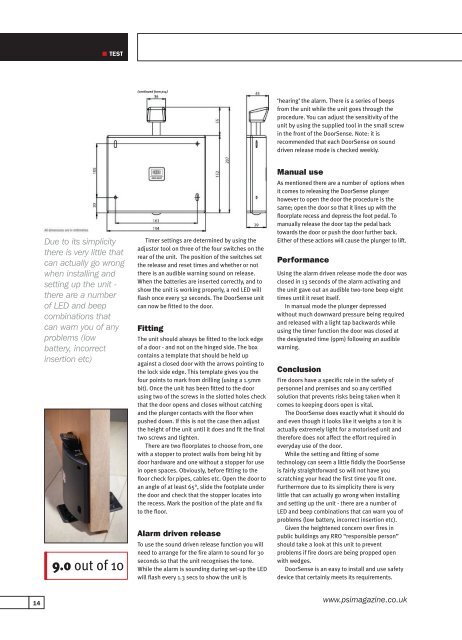PSINovember2017
You also want an ePaper? Increase the reach of your titles
YUMPU automatically turns print PDFs into web optimized ePapers that Google loves.
TEST<br />
(continued from p14)<br />
‘hearing’ the alarm. There is a series of beeps<br />
from the unit while the unit goes through the<br />
procedure. You can adjust the sensitivity of the<br />
unit by using the supplied tool in the small screw<br />
in the front of the DoorSense. Note: it is<br />
recommended that each DoorSense on sound<br />
driven release mode is checked weekly.<br />
Due to its simplicity<br />
there is very little that<br />
can actually go wrong<br />
when installing and<br />
setting up the unit -<br />
there are a number<br />
of LED and beep<br />
combinations that<br />
can warn you of any<br />
problems (low<br />
battery, incorrect<br />
insertion etc)<br />
9.0 out of 10<br />
Timer settings are determined by using the<br />
adjustor tool on three of the four switches on the<br />
rear of the unit. The position of the switches set<br />
the release and reset times and whether or not<br />
there is an audible warning sound on release.<br />
When the batteries are inserted correctly, and to<br />
show the unit is working properly, a red LED will<br />
flash once every 32 seconds. The DoorSense unit<br />
can now be fitted to the door.<br />
Fitting<br />
The unit should always be fitted to the lock edge<br />
of a door - and not on the hinged side. The box<br />
contains a template that should be held up<br />
against a closed door with the arrows pointing to<br />
the lock side edge. This template gives you the<br />
four points to mark from drilling (using a 1.5mm<br />
bit). Once the unit has been fitted to the door<br />
using two of the screws in the slotted holes check<br />
that the door opens and closes without catching<br />
and the plunger contacts with the floor when<br />
pushed down. If this is not the case then adjust<br />
the height of the unit until it does and fit the final<br />
two screws and tighten.<br />
There are two floorplates to choose from, one<br />
with a stopper to protect walls from being hit by<br />
door hardware and one without a stopper for use<br />
in open spaces. Obviously, before fitting to the<br />
floor check for pipes, cables etc. Open the door to<br />
an angle of at least 65°, slide the footplate under<br />
the door and check that the stopper locates into<br />
the recess. Mark the position of the plate and fix<br />
to the floor.<br />
Alarm driven release<br />
To use the sound driven release function you will<br />
need to arrange for the fire alarm to sound for 30<br />
seconds so that the unit recognises the tone.<br />
While the alarm is sounding during set-up the LED<br />
will flash every 1.3 secs to show the unit is<br />
Manual use<br />
As mentioned there are a number of options when<br />
it comes to releasing the DoorSense plunger<br />
however to open the door the procedure is the<br />
same; open the door so that it lines up with the<br />
floorplate recess and depress the foot pedal. To<br />
manually release the door tap the pedal back<br />
towards the door or push the door further back.<br />
Either of these actions will cause the plunger to lift.<br />
Performance<br />
Using the alarm driven release mode the door was<br />
closed in 13 seconds of the alarm activating and<br />
the unit gave out an audible two-tone beep eight<br />
times until it reset itself.<br />
In manual mode the plunger depressed<br />
without much downward pressure being required<br />
and released with a light tap backwards while<br />
using the timer function the door was closed at<br />
the designated time (9pm) following an audible<br />
warning.<br />
Conclusion<br />
Fire doors have a specific role in the safety of<br />
personnel and premises and so any certified<br />
solution that prevents risks being taken when it<br />
comes to keeping doors open is vital.<br />
The DoorSense does exactly what it should do<br />
and even though it looks like it weighs a ton it is<br />
actually extremely light for a motorised unit and<br />
therefore does not affect the effort required in<br />
everyday use of the door.<br />
While the setting and fitting of some<br />
technology can seem a little fiddly the DoorSense<br />
is fairly straightforward so will not have you<br />
scratching your head the first time you fit one.<br />
Furthermore due to its simplicity there is very<br />
little that can actually go wrong when installing<br />
and setting up the unit - there are a number of<br />
LED and beep combinations that can warn you of<br />
problems (low battery, incorrect insertion etc).<br />
Given the heightened concern over fires in<br />
public buildings any RRO “responsible person”<br />
should take a look at this unit to prevent<br />
problems if fire doors are being propped open<br />
with wedges.<br />
DoorSense is an easy to install and use safety<br />
device that certainly meets its requirements.<br />
14<br />
www.psimagazine.co.uk

















